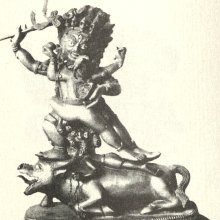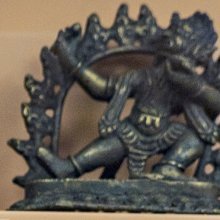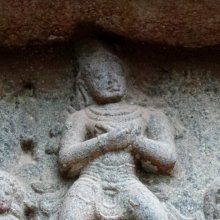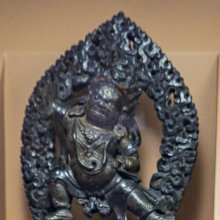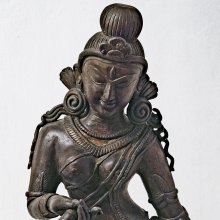Pratyalidha, Pratyālīḍha, Prati-alidha: 14 definitions
Introduction:
Pratyalidha means something in Hinduism, Sanskrit. If you want to know the exact meaning, history, etymology or English translation of this term then check out the descriptions on this page. Add your comment or reference to a book if you want to contribute to this summary article.
Images (photo gallery)
(+37 more images available)
In Hinduism
Natyashastra (theatrics and dramaturgy)
Source: archive.org: Natya ShastraPratyālīḍha (प्रत्यालीढ).—A type of standing-posture (sthāna);—Instructions: when the right foot is bent and the left foot is put forward in the Ālīḍha Sthāna the Pratyālīḍha will be produced.
(Uses): After taking an aim from the Ālīḍha Sthāna the missile to be [actually] released from the Pratyālīḍha Sthāna. The actor should release various weapons from this Sthāna.
Source: Shodhganga: The significance of the mūla-beras (natya)Pratyāliḍha (प्रत्यालिढ) refers to one of the nine maṇḍala (postures of the feet) which represents one of the four “movements of the feet” (pāda) according to the Abhinayadarpaṇa. Pratyāliḍha-maṇḍala is the reversed position of the ālīḍha-maṇḍala. The moment an arrow has been discharged from the bow, the body springs forward. This stance is called pratyālīḍhāsana in iconography.
Source: Shodhganga: Elements of Art and Architecture in the Trtiyakhanda of the Visnudharmottarapurana (natya)Pratyāliḍha (प्रत्यालिढ) refers to “one of the six kinds of standing postures for Men” (in Indian Dramas), according to the Viṣṇudharmottarapurāṇa, an ancient Sanskrit text which (being encyclopedic in nature) deals with a variety of cultural topics such as arts, architecture, music, grammar and astronomy.—Standing postures are determined separately for male and female. In the Viṣṇudharmottarapurāṇa six kinds of standing postures are discussed for men. Due to the edition of the prefix called prati which means opposite, pratyāliḍha posture denotes that posture which is totally the opposite of āliḍha posture. The Viṣṇudharmottarapurāṇa also agrees on it and accepts pratyāliḍha posture as the reverse form of āliḍha posture. According to the Nāṭyaśāstra, the soldiers release the missiles from pratyāliḍha posture after taking an aim from āliḍha posture.

Natyashastra (नाट्यशास्त्र, nāṭyaśāstra) refers to both the ancient Indian tradition (shastra) of performing arts, (natya—theatrics, drama, dance, music), as well as the name of a Sanskrit work dealing with these subjects. It also teaches the rules for composing Dramatic plays (nataka), construction and performance of Theater, and Poetic works (kavya).
Shilpashastra (iconography)
Source: Shodhganga: The significance of the mūla-beras (śilpa)Pratyālīḍha (प्रत्यालीढ) or Pratyālīḍhāsana similar to the pratyālīḍha-maṇḍala in Bharatanatyam, as defined according to texts dealing with śilpa (arts and crafs), known as śilpaśāstras.— In the pratyālīḍha-āsana, the arms and legs of ālīḍha have to be interchanged.
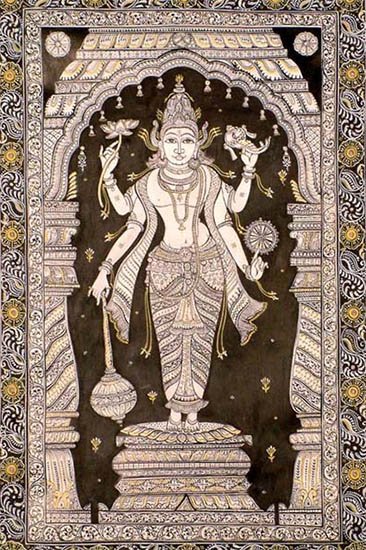
Shilpashastra (शिल्पशास्त्र, śilpaśāstra) represents the ancient Indian science (shastra) of creative arts (shilpa) such as sculpture, iconography and painting. Closely related to Vastushastra (architecture), they often share the same literature.
Purana and Itihasa (epic history)
Source: archive.org: Shiva Purana - English TranslationPratyālīḍha (प्रत्यालीढ) refers to the posture Lord Śiva assumed for a hundred thousand years, according to the Śivapurāṇa 2.5.10 (“The burning of the Tripuras”).—Accordingly, as Sanatkumāra narrated to Vyāsa: “Then Śiva, the great lord, seated in the chariot and equipped with everything, got ready to burn the three cities completely, the cities of the enemies of the gods. The lord stood in the wonderful posture of Pratyālīḍha for a hundred thousand years. The bow was well strung and kept near the head. The arrow was fixed. The fingers clenched at the bow firmly. The eyes were fixed. [...]”.

The Purana (पुराण, purāṇas) refers to Sanskrit literature preserving ancient India’s vast cultural history, including historical legends, religious ceremonies, various arts and sciences. The eighteen mahapuranas total over 400,000 shlokas (metrical couplets) and date to at least several centuries BCE.
Languages of India and abroad
Sanskrit dictionary
Source: DDSA: The practical Sanskrit-English dictionaryPratyālīḍha (प्रत्यालीढ).—A particular attitude in shooting (opp. līḍha q. v.).
Derivable forms: pratyālīḍham (प्रत्यालीढम्).
Source: Cologne Digital Sanskrit Dictionaries: Edgerton Buddhist Hybrid Sanskrit DictionaryPratyālīḍha (प्रत्यालीढ).—nt. (Sanskrit Lex.; Prakrit paccā°, [Paia-sadda-mahaṇṇavo]), a stance for a bowman, with left foot forward, right drawn back (so [Boehtlingk and Roth] and Tibetan on Mahāvyutpatti): Mahāvyutpatti 4267; Sādhanamālā 86.14; 123.6, etc.; opp. of ālīḍha, Mahāvyutpatti 4266, which occurs in Sanskrit, [Boehtlingk and Roth]. ([Paia-sadda-mahaṇṇavo] reverses the mgs.)
Source: Cologne Digital Sanskrit Dictionaries: Shabda-Sagara Sanskrit-English DictionaryPratyālīḍha (प्रत्यालीढ).—mfn.
(-ḍhaḥ-ḍhā-ḍhaṃ) Eaten. n.
(-ḍhaṃ) A particular attitude in shooting, the left foot advanced and right retracted. E. prati and āṅ before, lih to lick, aff. kta .
Source: Cologne Digital Sanskrit Dictionaries: Monier-Williams Sanskrit-English Dictionary1) Pratyālīḍha (प्रत्यालीढ):—[=praty-ā-līḍha] mfn. (√lih) eaten, [cf. Lexicographers, esp. such as amarasiṃha, halāyudha, hemacandra, etc.]
2) [v.s. ...] extended towards the left, [cf. Lexicographers, esp. such as amarasiṃha, halāyudha, hemacandra, etc.]
3) [v.s. ...] n. a [particular] attitude in shooting (the left foot advanced and right drawn back), [cf. Lexicographers, esp. such as amarasiṃha, halāyudha, hemacandra, etc.]
Source: Cologne Digital Sanskrit Dictionaries: Yates Sanskrit-English DictionaryPratyālīḍha (प्रत्यालीढ):—[pratyā+līḍha] (ḍhaḥ) 1. m. The attitude in shooting. a. Eaten.
Source: DDSA: Paia-sadda-mahannavo; a comprehensive Prakrit Hindi dictionary (S)Pratyālīḍha (प्रत्यालीढ) in the Sanskrit language is related to the Prakrit word: Paccālīḍha.
[Sanskrit to German]
Sanskrit, also spelled संस्कृतम् (saṃskṛtam), is an ancient language of India commonly seen as the grandmother of the Indo-European language family (even English!). Closely allied with Prakrit and Pali, Sanskrit is more exhaustive in both grammar and terms and has the most extensive collection of literature in the world, greatly surpassing its sister-languages Greek and Latin.
Kannada-English dictionary
Source: Alar: Kannada-English corpusPratyālīḍha (ಪ್ರತ್ಯಾಲೀಢ):—
1) [noun] a particular attitude in shooting, with the left foot advanced and the right drawn back.
2) [noun] (dance.) a similar attitude.
Kannada is a Dravidian language (as opposed to the Indo-European language family) mainly spoken in the southwestern region of India.
See also (Relevant definitions)
Partial matches: Lidha, Prati, Alidha.
Starts with: Pratyalidhapada, Pratyalidhasana, Pratyalidhasthana.
Full-text (+81): Paccalidha, Dhanvisthana, Prasena, Varshasahasraka, Pratyalidhasana, Pratyalidhapada, Ucchushmajambhala, Vajravidarani, Paryastaka, Bhadra, Rupika, Cumbika, Sabalika, Anuvarti, Bhairavi, Kankalika, Kurukullika, Shekhi, Shikhandi, Dimbha.
Relevant text
Search found 9 books and stories containing Pratyalidha, Pratyālīḍha, Prati-alidha, Pratyā-līḍha, Pratya-lidha, Prati-ālīḍha; (plurals include: Pratyalidhas, Pratyālīḍhas, alidhas, līḍhas, lidhas, ālīḍhas). You can also click to the full overview containing English textual excerpts. Below are direct links for the most relevant articles:
Amarakoshodghatana of Kshirasvamin (study) (by A. Yamuna Devi)
Education (10): Knowledge in Archery < [Chapter 4 - Cultural Aspects]
The Indian Buddhist Iconography (by Benoytosh Bhattachacharyya)
Figure 235 - Hindu Gods: Vajrasarasvatī
Figure 130 - Emanations of Akṣobhya: Ucchuṣma-Jambhala
Nitiprakasika (Critical Analysis) (by S. Anusha)
Natyashastra (English) (by Bharata-muni)
Part 7 - Data of India’s Cultural History in the Nāṭyaśāstra < [Introduction, part 1]
Gati in Theory and Practice (by Dr. Sujatha Mohan)
Gait identified in the martial arts of India < [Chapter 4 - Practice of Gati]
Gati in vehicles < [Chapter 3 - Application of gati in Dṛśya-kāvyas]
Gati used for the delineation of Bhāva and Rasa < [Chapter 3 - Application of gati in Dṛśya-kāvyas]
Stupas in Orissa (Study) (by Meenakshi Chauley)
Emanations of Amoghasiddhi < [Chapter 5]
Drum slabs at at Ratnagiri < [Chapter 4]
Minor Votive Stupas at Ratnagiri < [Chapter 4]
